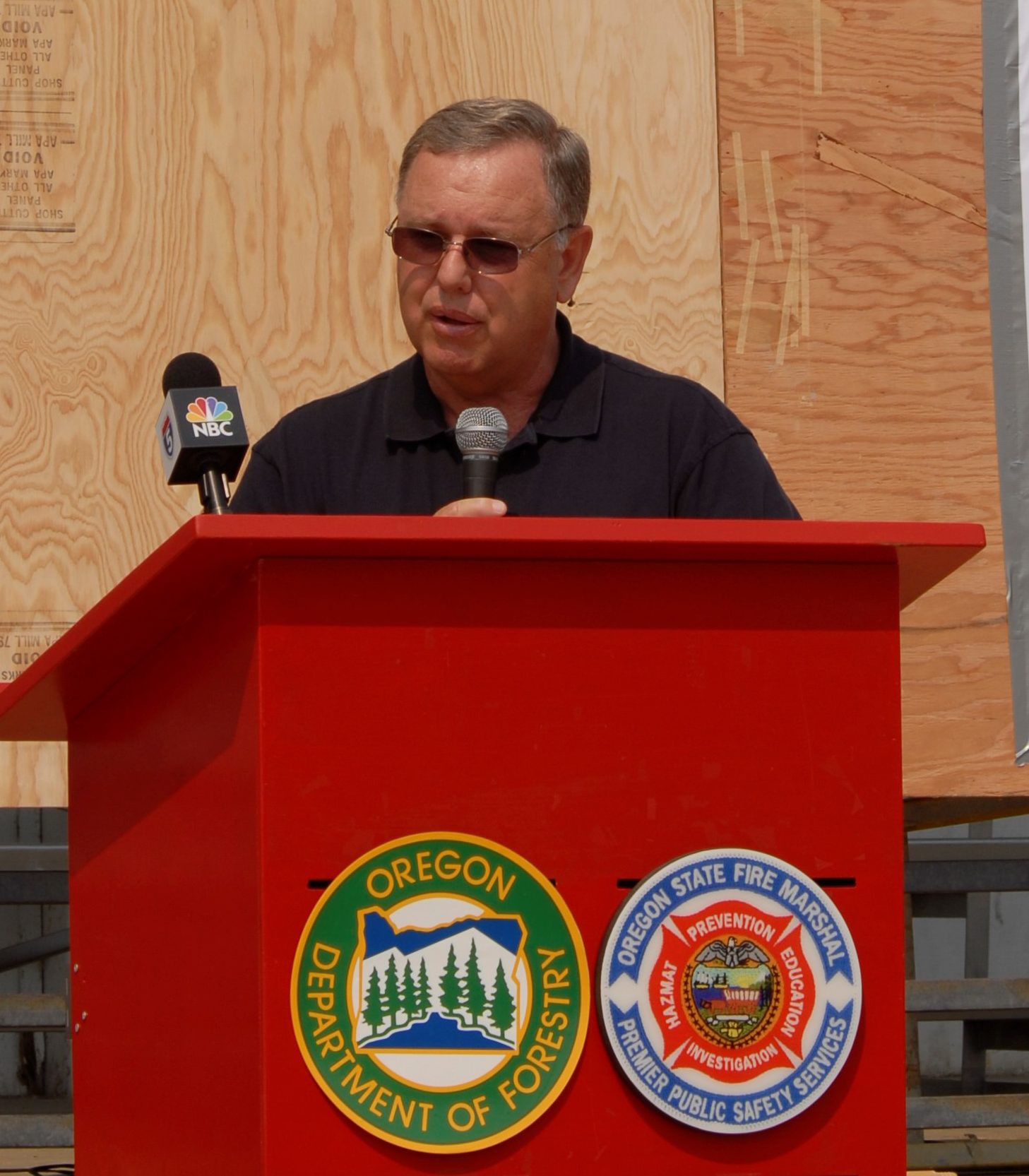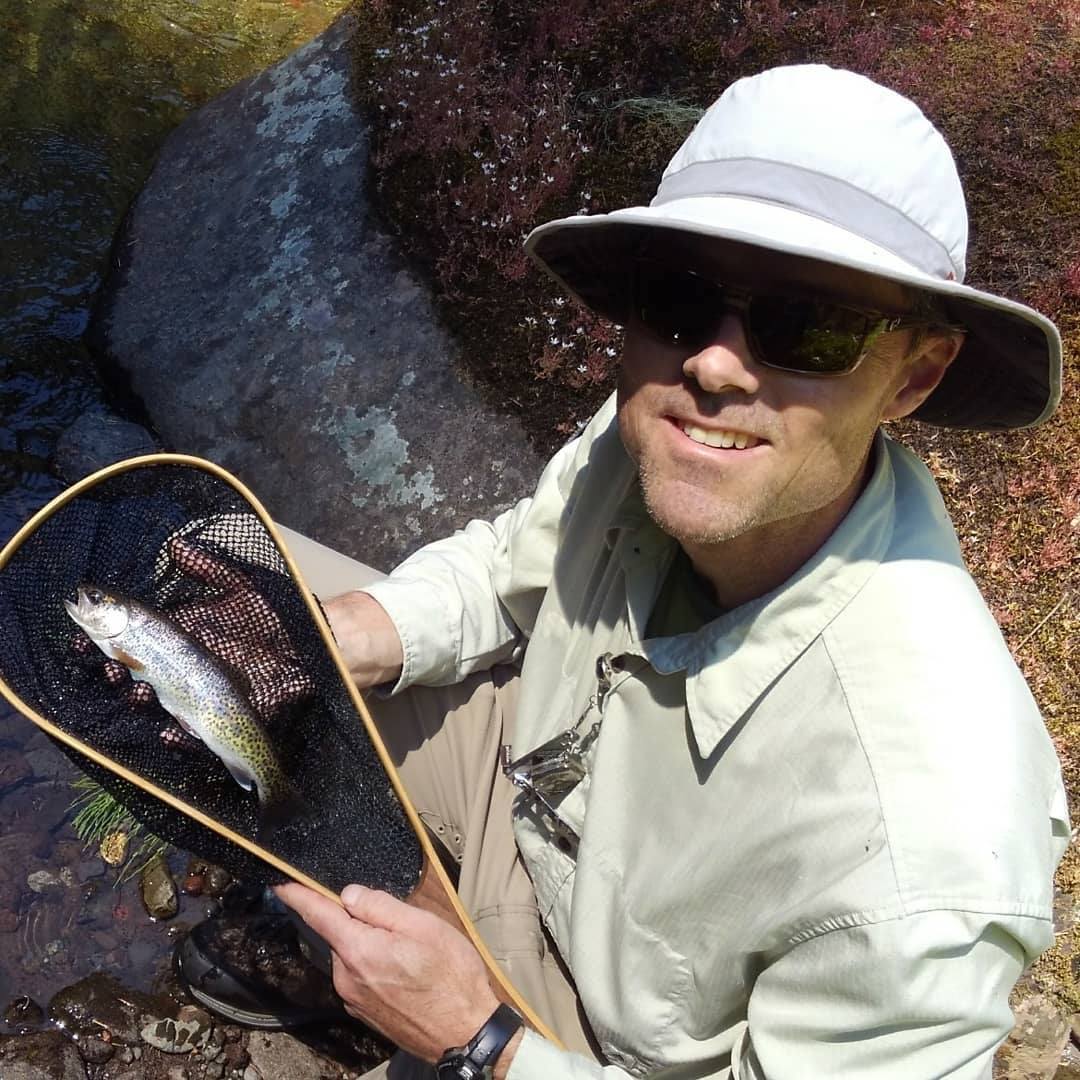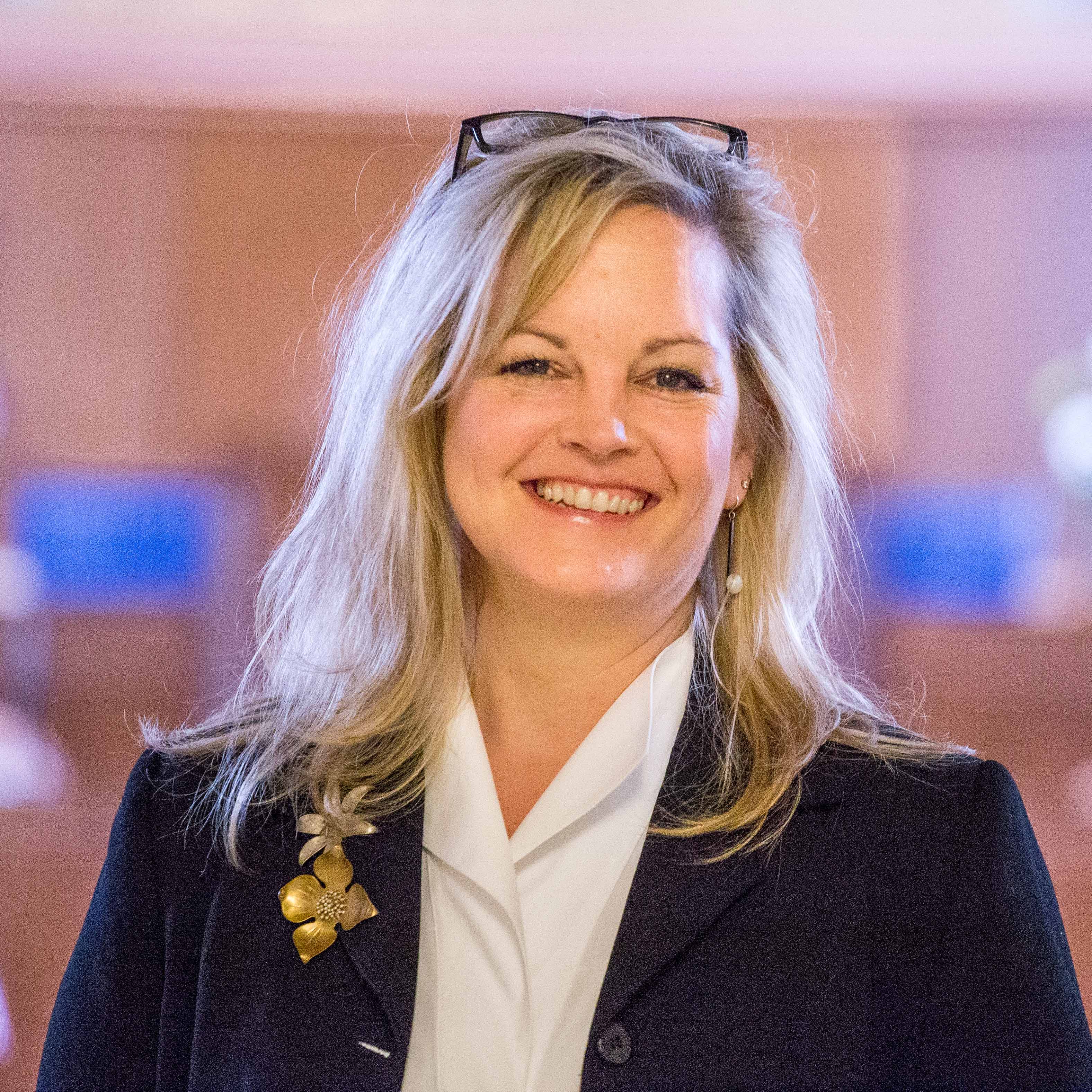**current Guest Opinions now appear in the News section of this website
Private forestland is not the problem – Dec 23, 2018 – Melvin Thornton, Medford Mail Tribune

In a Dec. 9 opinion (“Reform the Oregon Forest Practices Act”) botanist Jason Clark blames industrial forestry practices for recent wildfires. Anyone with an Oregon ownership map could tell you his argument does not hold up.
The smoke we’ve been experiencing is not coming from private industrial forests, it’s coming from unchecked fires on federal forests. No need for mental gymnastics and expensive research to make the connection — the numbers speak for themselves.
Between 2008 and 2017, roughly 80 percent of the acres that burned in Oregon wildfires were on U.S. Forest Service ground. While hotter and drier summers may contribute to increased numbers of fires, that’s not the end of the story. Fires started by lightning, which is the primary cause of large wildfires, don’t distinguish between land ownerships. For example, in the 2017 fire season an equal number of fires started on federal forests and private forests, but roughly 96 percent of the burned acres were in federal forests. The same pattern happened last summer: Half of the fire starts were in private forests, but 70 percent of the acres burned were on federal ground and only 5 percent of the total acres burned were on privately managed timberlands.
There is no way one could conclude from those numbers that private forestry practices are causing wildfires — it’s just not true. When fires start in our forests, we safely and aggressively put them out. Private landowners invest heavily to maintain good roads that provide forest access. Sustainably managed forests ensure vigorous, healthy forests that aren’t overstocked or riddled with diseased, dead and dying trees.
If the numbers aren’t convincing enough — there’s another glaringly obvious fact Clark misses when he blames Oregon’s forestry practices for causing wildfires. California has the most overly burdensome regulatory restrictions on forestry in the nation. Yet Californians are suffering through the worst forest fires in the West. How could one possibly conclude that’s a function of not enough regulation on private forests?
I’m no botanist like Clark, but I am a professional wildland firefighter with over four decades of real-life experience fighting fire in Southern Oregon. Clark references a study of the 2013 Douglas Fire in Southern Oregon. As the Douglas Forest Protective Association district manager at the time, I was responsible for managing that fire, and I can tell you we don’t need a study to confirm that fire does more damage to young trees than old ones. What the study missed is the important part — many of the fires that contributed to the complex began on federal forests (with heavy fuel loads) and spread to young, 15- to 40-year-old private forests, where the fire was stopped. In my experience, many large fires were stopped or contained in managed stands, due to less dead fuel and more access.
Contrary to Clark’s assertion, Oregon forestry observes some of the strictest environmental protections in the nation. The Oregon Forest Practices Act was landmark legislation in 1971 and remains current today with nearly 40 revisions since to adopt best practices and evolving science.
Notably, the OFPA requires reforestation after harvest, but reforestation after fire is not required. Private forests are rehabilitated after fire and replanted, because private timber owners strive to get that land back to healthy, productive forestland. Federal forests mostly remain charred, with thousands of dead trees that pose a major safety threat to all future firefighters and the public.
Clark and I do agree on one point: Oregonians need strong political leadership to address the wildfire issue. Rampant, unchecked megafires in federal forests have catastrophic consequences for our safety, health, communities, economy and environment. Our state is losing millions in tourism dollars, and Oregonians are being evacuated from their homes and suffering unhealthy air quality. One large wildfire season can produce twice as much air pollution as all the cars in Portland produce in one year. There’s got to be a better way.
Private forests capture carbon dioxide out of the atmosphere and store it in renewable, environmentally friendly building products. We can either store carbon in locally grown, sustainable wood products, and replant trees, or we can release carbon as smoky air pollution straight into the atmosphere when our overstocked federal forests burn.
I hope our policy-makers encourage the use of Oregon-grown wood from federal forests. Our private forests are managed for fire resiliency and produce environmentally friendly products; a symbol of what makes Oregon great. Federal forests should do the same.
Melvin Thornton is a small woodland and ranch owner in southwest Oregon, who spent over 40 years as a firefighter and served as the district manager for the Douglas Forest Protective Association.
https://mailtribune.com/opinion/guest-opinions/private-forest-land-is-not-the-problem
Our choice: Use forests for products, or breathe them as smoke – Aug 23, 2018 – Ted Reiss, Eugene Register-Guard,

Last week Lincoln City hosted hundreds of policy-makers, including our state senators and representatives, at the annual Oregon Coastal Caucus Economic Summit. Its purpose was to discuss carbon cap-and-trade mechanisms and ways to reduce Oregon’s carbon footprint. The timing couldn’t have been more poignant: Catastrophic wildfires are ripping through Oregon’s forests, torching decades of carbon storage captured in trees and emitting concentrated levels of carbon and toxic pollutants into our airshed.
As policy-makers consider solutions, one opportunity is as clear as the air we should be breathing: Work to reduce forest fires by encouraging the use of wood growing in federal forests.
An area roughly the size of Rhode Island burned last summer in Oregon. An equal number of fires started in federal and private forests, but roughly 95 percent of the acres burned were in federal forests. The trend continues this summer — an area larger than Portland and Seattle combined is burning today in Oregon, and roughly 75 percent is in federal forests.
Meanwhile, most of Oregon’s softwood lumber production comes from private forests. Private forests are not burning as extensively, and they produce more (carbon-storing) softwood lumber than any other state. How? By reducing wildland fire fuels through harvest, replanting and regenerating a new carbon cycle, by maintaining good road access in forests, and by limiting burned acres by aggressively putting fires out.
Southern Oregon has been living a smoky reality for weeks — fires around Ashland have forced Oregonians to breathe the worst-quality air in the nation. Once again, the Oregon Shakespeare Festival is cancelling outdoor performances due to smoke, costing the regional economy millions. The Oregonian recently reported that due to wildfire smoke, air quality in Portland was ranked fourth worst in the world, behind places like Mumbai, India, and Dubai in the United Arab Emirates.
Medical experts claim breathing this kind of wildfire smoke is equivalent to a non-smoker smoking a pack of cigarettes a day. Last summer Oregon experienced 160 days that were officially categorized as Unhealthy for Sensitive Groups, and in September emergency room visits were 86 percent higher than normal. Studies have also shown that one large wildfire can release twice as much carbon into the atmosphere as all the cars in Portland produce in one year.
Carbon leaves the forest in three primary was: as smoke, through natural biological breakdown or in building products. We should be working to decrease the smoke and increase the removal of valuable wood products. Lumber, paper or other items we use every day continue to store carbon for the life of the product. For every tree that’s harvested in Oregon, four are planted to replace it, starting the carbon sequestration cycle anew. Moreover, using wood building products permanently avoids using more carbon-intensive building products.
Immediately after the Horse Prairie Fire of 2017 scorched approximately 16,000 acres in southwest Oregon, salvage harvesting began on private land. The same occurred following the devastating fires of 2013 and 2015. The same can be said for many historical fires, including the Tillamook Burns and the Oxbow Burn southwest of Eugene in the 1960s.
These days, almost zero salvage harvesting occurs on federal forests. Leaving standing dead trees only invites more lightning-caused fires and increases safety risks for firefighters. Managing these lands for fire resiliency through active forest management can reduce devastating impacts from smoke and provide good carbon cycle benefits.
More than half of all forests in Oregon are owned by the federal government. Our policymakers can do something to improve Oregonians’ health risks, reduce forest fires and mitigate climate change: Encourage the use of Oregon-grown wood from federal forests. Private forests are sustainably managed for fire resiliency and produce environmentally-friendly products for the world. Federal forests should do the same.
Ted Reiss of Eugene has been a professional forester for 24 years and is a member of the Society of American Foresters.
Federal forestland in Oregon needs to be managed differently – Aug 10, 2018 – Seth Barnes, Salem Statesman-Journal

This summer our skies are choked with smoke – again. The sky is orange and the smell and taste of smoke is pervasive. As a native Oregonian, I know it’s getting worse.
It doesn’t have to be this way. Two-thirds of Oregon’s forests are federally-owned, and the smoke we’re inhaling today is due to their lack of management or harvest for decades. The solution is simple: continue sustainable harvest of wood in Oregon’s private forests and increase harvest on federal forests.
Rampant, unchecked megafires in federal forests have catastrophic consequences for our safety, health, communities, and economy. Last summer, more than 7,600 people were evacuated from their homes. Oregonians suffered unhealthy air quality, emergency-room visits spiked, and the cancellations of Oregon Shakespeare Festival performances, the Sisters Folk Festival, and Cycle Oregon cost our state millions in tourism dollars.
An area roughly the size of Rhode Island burned last summer in Oregon. An equal number of fires started in federal and private forests, but roughly 95 percent of the acres burned in federal forests.
What does that tell us? Private forest fires are easier to put out.
Why? We reduce fuels through harvest, replant, maintain access to the woods, and put fires out.
Working Forests Help Oregon Fight Climate Change – June 26, 2018- Jed Arnold, Daily Astorian

I’m lucky to be able to spend most days in the woods, helping to look after the sustainability and health of 33,000 acres of Hampton Lumber’s forestland here in Clatsop County.
As a family-owned wood products company, our outlook is inherently multi-generational. Our foresters plant trees they have no expectation of seeing harvested before they are retired. The Hampton family is committed to ensuring the next generation inherits a business that is healthy and sustainable, both economically and ecologically.
The work we do every day is focused on ensuring our forests are as healthy in 50 years as they are today. We recognize how climate change could affect forest and community health.
I hope it is understandable, then, just how frustrating it is for those of us in Oregon’s forest sector to see a new line of attack by groups opposed to commercial forestry: the claim that forestry operations are the primary source of carbon emissions in the state. There are some eye-popping numbers being put forward by groups whose main goal appears to be to reduce or eliminate timber harvests in our state. However, closer examination of the source material for these claims reveals they are less scientific analysis and more creative interpretations of carbon accounting and policy language.
Like so much of the science relating to climate change and its effects, proper forest carbon accounting is complex and the subject of ongoing research and debate. It is worth noting, however, that the UN’s International Panel on Climate Change specifically identified sustainable forest management for “timber, fibre or energy” as a key tool in mitigating carbon emissions. In fact, several Northern European nations — often seen as leaders in the green movement by environmentalists in the U.S. — are actually increasing the actively managed forests in their countries as a component of their strategy to combat climate change.
Sustainable timber harvest as a strategy to fight climate change makes a lot of sense when one looks at modern forest management and timber production in the proper context —through a long-term life cycle analysis. A good portion of a tree’s carbon remains stored in the wood products that are created from it, locking that carbon away for the life of the product, while atmospheric carbon is taken up by the tree planted in its place. This is particularly important when those products are lumber used in housing and other construction. It’s also worth noting that every building material, piece of furniture and even kitchen utensil made from wood means one less product made from iron, aluminum, concrete or plastic, all of which emit significantly more greenhouse gases during their production.
While it does take some years for a newly planted tree to reach the carbon capture potential of a mature one, trees grow faster here on the North Coast than almost anywhere else in the world and that difference is quickly made up for. When consideration is given to carbon uptake over the entire lifespan of the tree and the life cycle of wood products, Oregon’s working forests are shown to be a net carbon sink. Said another way, commercial forests in Oregon are already absorbing and locking away more carbon than is emitted to manage them.Subscribe Now: 1 month free with $8 monthly digital only subscription. Promo Code: DIGI
Carbon release through deforestation is a very real threat — just not in Oregon. Deforestation is defined as the conversion of forestland to a non-forest use (e.g. agriculture or development). There is virtually no deforestation taking place in the state and what little is occurring is due to conversion of forestland into housing. In fact, the Oregon Department of Forestry estimates that 92 percent of the land that was forested in 1850 remains forested today.
A good portion of forest loss outside of the U.S. is due to logging to meet the world’s ever-growing appetite for agricultural and wood products. If one is truly concerned about climate change, it is important to remember we live in a global economy and every tree we do not cut here, in a place with strict environmental protections and replanting laws, is a tree that will be cut somewhere else in the world, likely from a forest that will be lost — along with its carbon storage capacity — for many lifetimes.
There is something deeply cynical about proposals that suggest Oregon could meet the majority of its goals for net carbon output by halting harvests in our forests. It should be the responsibility of all Oregonians, indeed all residents of more developed countries, to make the necessary changes in our lifestyle to reduce our carbon emissions. To demand that the residents of rural counties sacrifice their way of life and renewable natural resources economy — our rare comparative advantage — so that urban residents can continue their consumption without further inconvenience strikes me as unfair. Further, to suggest that the handful of jobs created through forest restoration projects would come anywhere close to replacing the thousands of high-skill, living-wage forest and sawmill jobs that would be lost in a coastal carbon storage scheme reveals a lack of understanding about the modern forest economy in our county.
These forests are our livelihoods, our schools, our public services, and our privilege and responsibility to sustain for a variety of uses and benefits. Reducing the amount of timber we sustainably harvest in Oregon will do more to harm efforts to reach a global reduction in CO2 levels than help them. But even if we choose to ignore this and focus on Oregon’s carbon reduction goals as though we were in a bubble, why would we ask rural Oregonians to give up more working-class jobs and more school funding dollars when our working forests are already part of the solution to climate change?
I invite you to learn more about working forests and talk to those who make their living in the renewable wood products sector. There are a lot of us here on the North Coast. Rural or urban, we’re all in this together. Let’s work together so our forests can continue to sustainably provide for a multitude of benefits.
Jed Arnold is community outreach and stewardship coordinator for Hampton Family Forests on the North Coast.
A vibrant wood products market is good for Oregon and the climate – May 5, 2018 – Kristina McNitt, Oregonian

In his April 21 op-ed “Our forests can make Oregon the first carbon-neutral state,” Dominick DellaSala proposes that the state can achieve this feat by disincentivizing wood production from our forestlands. He believes that Oregon’s forests have the potential to be a large carbon sink, and that they should be managed to more aggressively offset emissions from other sectors. We are confident that his proposals would not actually decrease global carbon emissions and would come at great cost to Oregonians.
DellaSala alludes to the fact that Oregon’s forests are already sequestering huge amounts of carbon. What he doesn’t tell you is that this is true across all ownership classes. Federal forestlands, state forestlands and private industrial forestlands are all growing more trees every year than are harvested or lost to wildfire or mortality. In fact, the 30 million acres of forestland across the state are sequestering approximately half of all of Oregon’s carbon emissions every year.
But rather than praise Oregon forest landowners for being part of the climate change solution, DellaSala proposes that they bear ever more of the burden. By taxing industrial landowners and paying others to stop cutting trees, he believes that even more carbon emissions from other sectors can be stored on Oregon forestlands. Putting aside the fundamental inequity of making forestland owners solve a problem caused by others, curtailing harvest means curtailing the forest products industry and all of the otherwise carbon-neutral employment in rural communities those industries support.
But the real punchline is this: Domestic development and redevelopment will not stop. New houses are built every day in Oregon and across the United States. By reducing the state’s wood production, we only ensure that developers turn to wood from other jurisdictions with more lenient environmental protections than we have here. Or worse, that they use less-climate-friendly alternatives to wood. For this reason, DellaSala’s proposals would not actually decrease global carbon emissions and, in fact, could increase net emissions depending on what products are substituted for wood.
We hope that reasonable people see DellaSala’s op-ed for what it is: A thinly-veiled anti-logging agenda. In most mainstream circles working on climate change issues, including the International Panel on Climate Change, use of wood products is strongly encouraged. The panel concluded that in “the long term, a sustainable forest management strategy aimed at maintaining or increasing forest carbon stocks, while producing an annual sustained yield of timber, fiber or energy from the forest, will generate the largest sustained mitigation benefit.”
Of course, wood products come from trees. And there’s no better place in the world to grow (and re-grow) trees than Oregon. In light of its positive contribution to climate change, we look forward to working with state lawmakers on finding ways to encourage the use of more Oregon wood, not less.
Kristina McNitt is president of the Oregon Forest & Industries Council, which is based in Salem.
https://www.oregonlive.com/opinion/2018/05/a_vibrant_wood_products_market.html
A well-managed forest means less greenhouse gas loose in the environment – Apr 8, 2018 – Noelle Arena, Eugene Register-Guard

It’s telling that Shannon Wilson’s Feb. 25 guest viewpoint, “To address climate change, stop clear-cutting,” complains that some of Oregon’s larger environmental organizations “ignore” the carbon impacts of clear-cutting. Perhaps, rather than committing “environmental nonprofit malpractice” as Wilson asserts, these organizations are smart enough to acknowledge widely accepted, peer-reviewed science indicating that active forest management is indeed carbon-neutral.
The Oregon Society of American Foresters — along with the Oregon Legislature, the U.S. Congress and many other policy and scientific organizations — joins those environmental organizations in supporting the assertion that sustainably managed forests can reduce greenhouse gas concentrations by sequestering atmospheric carbon in trees and soil, and by storing carbon in wood products made from the harvested trees.
Science supports it
The OSAF, representing more than 800 Oregonians in forestry and natural resources professions, is the largest state affiliate of the national Society of American Foresters. Our members play a major role in managing Oregon’s 30 million acres of forest land. We are committed to establishing professional excellence and advancing the science, education, technology and practice of forestry.
SAF has an extensive position paper with a plethora of scientific citations on forest management and climate change (http://bit.ly/2FdisBP), but the gist is that forestry literally uses sunlight to take carbon out of the air and turn it into renewable and sustainable building products. Life-cycle analyses reveal that lumber, wood panels and other solid wood products store more carbon, emit fewer greenhouse gases and use less fossil energy than steel, concrete, brick or vinyl, whose manufacture is energy intensive and produces substantial emissions.
More than 40 million tree seedlings are hand-planted in Oregon every year, starting anew the carbon sequestration cycle. Reforestation is one of the many things required by the Oregon Forest Practices Act, including a requirement that within six years those new seedlings (more than 200 per acre) are thriving and outgrowing competing grass and brush on their own.
As those trees grow, they not only clean our air but also provide Oregonians with the cleanest drinking water of any land use in the state, ample recreation opportunities and breathtaking vistas of forests abundant with wildlife habitat.
Wood stores carbon
Roughly 50 percent of the dry weight of wood is carbon, and that carbon remains locked in wood products produced from Oregon’s forests for the entire life of those products, long after those reforested acres grow into healthy, lush forests. In fact, because one cubic meter of wood stores nearly a metric ton of carbon dioxide, Carbon12, an eight-story condominium building currently being constructed in Portland with extensive use of mass timber products, will offset 577 metric tons of carbon dioxide emissions from going into the atmosphere. That’s equivalent to keeping 169 cars off the road for a year — with one building.
Wood is the ultimate green building material because it is the only major building material that stores carbon. It’s renewable, recyclable, and in Oregon, it’s sustainably and locally produced. Wood produced from Oregon forestland regulated by the state’s forest protection law qualifies as responsibly sourced under the internationally recognized American Society of Testing Materials standard, and therefore can count toward the Leadership in Energy & Environmental Design credit for wood use in sustainable building projects.
Oregonians should be proud of these things. I know I am.
I entered this career with an intense love and respect for our state’s forests. We live in a state with some of the strictest environmental protections for forestry in the nation, and Oregon’s climate is one of the best in the world for growing trees. We should be encouraging the use of wood products that provide jobs for more than 60,000 Oregonians, many in rural areas, not creating concern for a problem that doesn’t exist.
Check federal forests
If Wilson needs a problem to focus on, a good project might to encouraging active management of the 60 percent Oregon’s forestland that’s owned by the federal government. For weeks last summer, Oregonians choked on smoke from fires in these overgrown, overstocked and undermanaged forests — think breathing in carbon particulates. Of the more than 700,000 acres that burned in Oregon last summer, 96 percent were in federal forests.
Unlike when we harvest that carbon and store it in building materials, when that carbon is released into the atmosphere in the form of smoke, there is no requirement to replant those burned acres. Anyone who has ever driven past a federal forest burn scar can see what’s left after a catastrophic wildfire years later: standing black dead trees.
Compare that to a clear cut that’s been replanted — within a few short years, it is again actively storing carbon at high rates while providing environmental benefits of clean air, clean water and wildlife habitat. I’ll take the latter, and I think most Oregonians would agree.
Background
Noelle Arena has been a forester for seven years. She has served as the Oregon Society of American Foresters Eugene Chapter Chair for three years, and is in her first year as the Communications Chair for the State Committee. She says forestry is not only her career, but also her passion and devotes most of her personal time to forestry education and community involvement. She also enjoys hiking the many trails of Oregon with her dog, Ellie.
Manage our forests with science, not ideology – Aug 18, 2016 – Seth Barnes, Eugene Register-Guard

Since the middle of June more than half a dozen opinion pieces have appeared in the Register Guard about management of timber, some attacking forest management practices and some standing up for the industry. Even for someone like me, who is intimately familiar with forestry – it’s a lot. The most recent piece by Jason Gonzales, (Oregon’s Outdated Logging Rules Need Reform, August 3) compels me to offer another perspective and clarify the facts.
Mr. Gonzales and I have one thing in common: we’re both registered lobbyists for organizations with clear objectives. He is a lobbyist for an environmental organization while I work for a trade association representing forest landowners. One could say that makes neither of us objective.
However, I’m also a professional forester and a former agency regulator. Maybe more importantly, Oregon’s forests are a big part of who I am. I have long family ties to Oregon’s forests – my grandfather managed land in Lane County, and I grew up helping my dad manage our family forestland. Those experiences inspired me to pursue a degree in Forest Management from Oregon State and a career in the timber industry. I understand the concern about how forests are managed because as a father raising my children in Oregon, I want strong environmental protections for them. My children regularly help out on my father’s forestland and swim in the cold water filtered by the forest. They see butterflies, deer, elk, and songbirds all thriving in open habitat created by clearcuts. It’s important to me that they value sustainable forestry so one day they, too, can manage our natural resources for the next generation.
It’s through this lens that I feel compelled to weigh in and I can say with professional confidence that Oregon has some of the strictest and most science-based forest protection laws and management practices in the world.
A large portion of Oregon’s forest practice rules are aimed at protecting water quality, fish and wildlife. The indisputable fact is that actively managed forests provide abundant clean water – state agencies confirm the best water quality in the state comes from forested watersheds, including those that have significant management. Clearcuts are heavily regulated in Oregon – the size is limited and landowners are required to protect rivers, streams and provide wildlife habitat. Clearcuts provide real benefits: abundant sunlight is required to re-establish shade-intolerant Douglas-fir forests and clearcuts mimic natural disturbance like fire and provide habitat for species like the northern alligator lizard that requires clearings for foraging and basking.
Furthermore, foresters are required by law to replant when we harvest. There is no “cut and run” in Oregon – that’s illegal – and there is no Douglas-fir monoculture. We plant more than four million tree seedlings every year, species such as Douglas-fir, Hemlock, Cedar, Noble Fir or Spruce. It’s the local forester’s job to assess the site and figure out what mix of trees to replant in order to grow a vigorous and healthy forest. Then we make sure those seedlings grow successfully into a new forest. Oregon law requires that reforested areas must be vigorous enough to out-compete grass and brush within six years. It’s for this reason that we sparingly use pesticides once or twice over 40 to 60 years to give seedlings an opportunity to out-grow invasive weeds like scotch broom and blackberry that threaten to choke them out. Put in perspective, forestry is collectively responsible for just four percent of total annual pesticide use in Oregon.
Actively managed forests provide ongoing environmental benefits while still providing the most sustainable and eco-friendly building materials available. Not to mention the tens of thousands of family-wage jobs created for Oregonians.
Modern forestry relies heavily on research, applied science, and experiential knowledge. This is how natural resources should be managed – with science, not with ideology. If you have questions about what happens in the forest, I’d encourage you to follow our Facebook page, Oregon Tree Talk, or visit our website at www.ofic.com for information about what actually happens in the woods from the people actually doing it.
Seth Barnes is the Director of Forest Policy for Oregon Forest & Industries Council, a trade association representing more than 50 Oregon forestland owners and forest products manufacturers.
